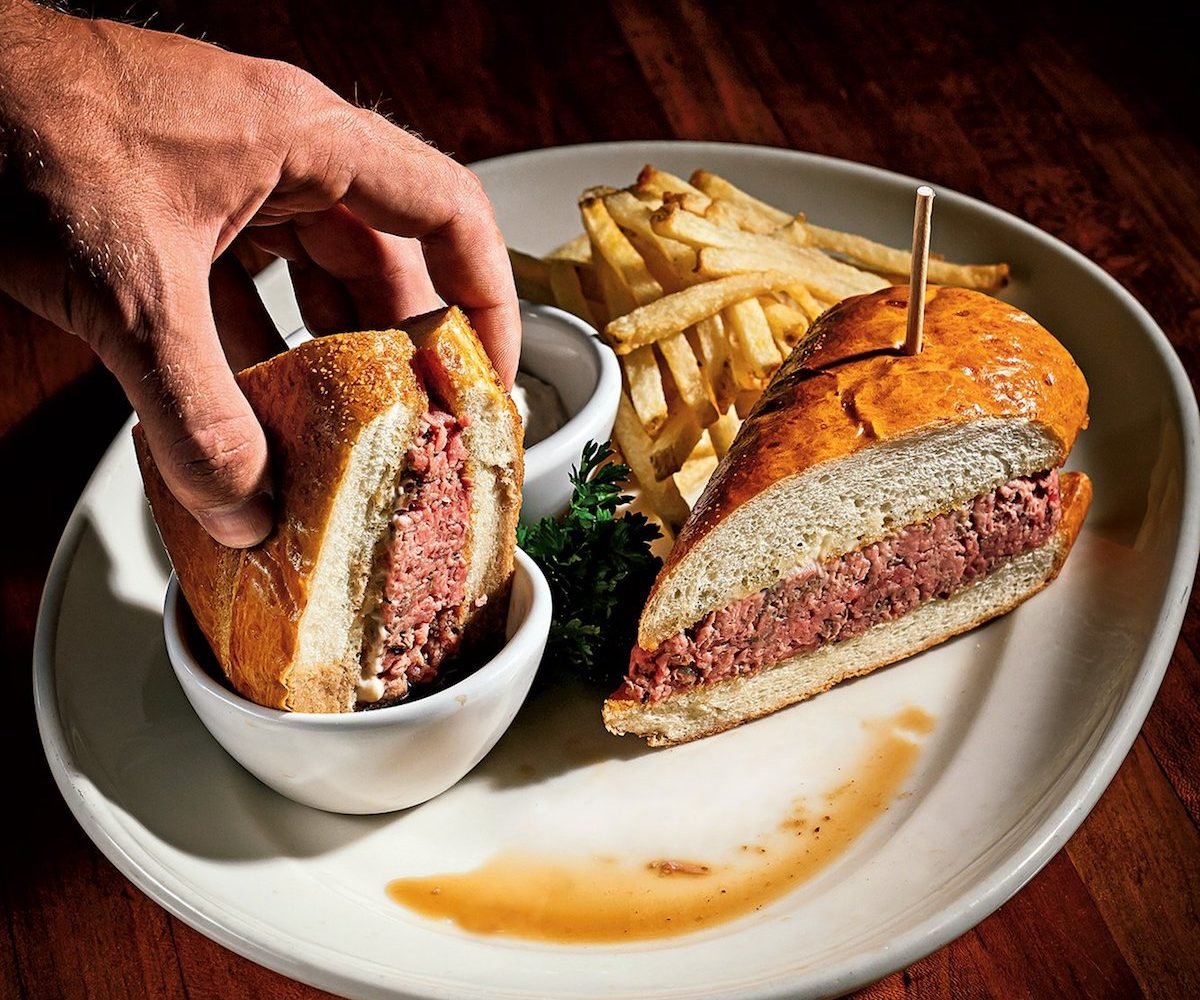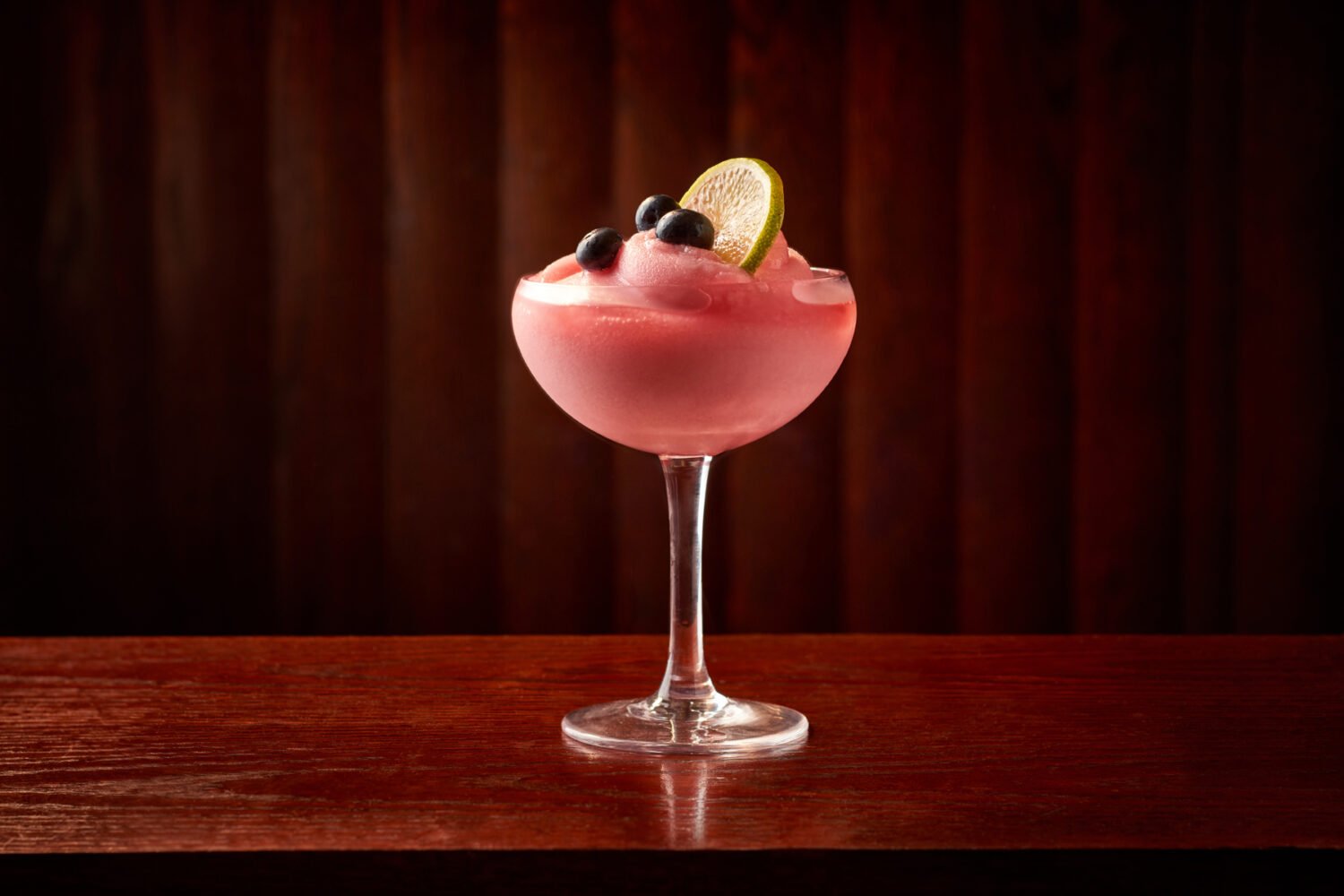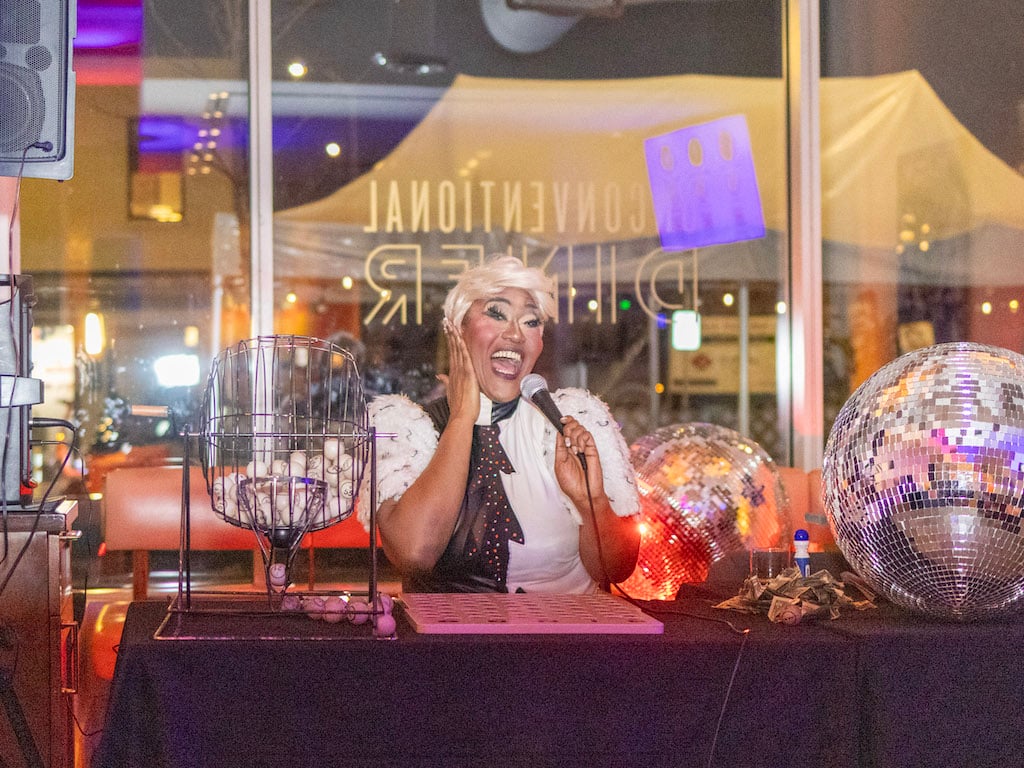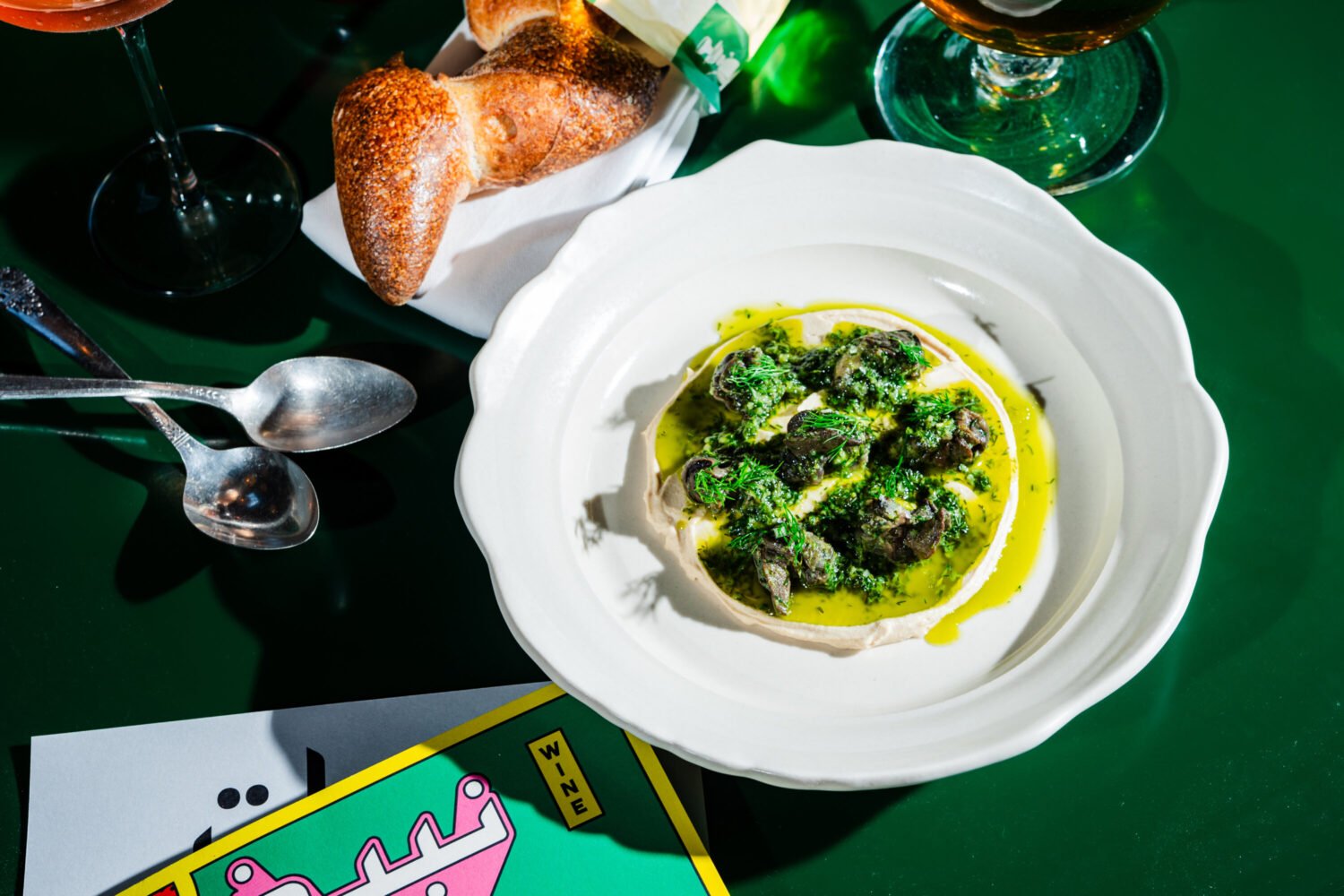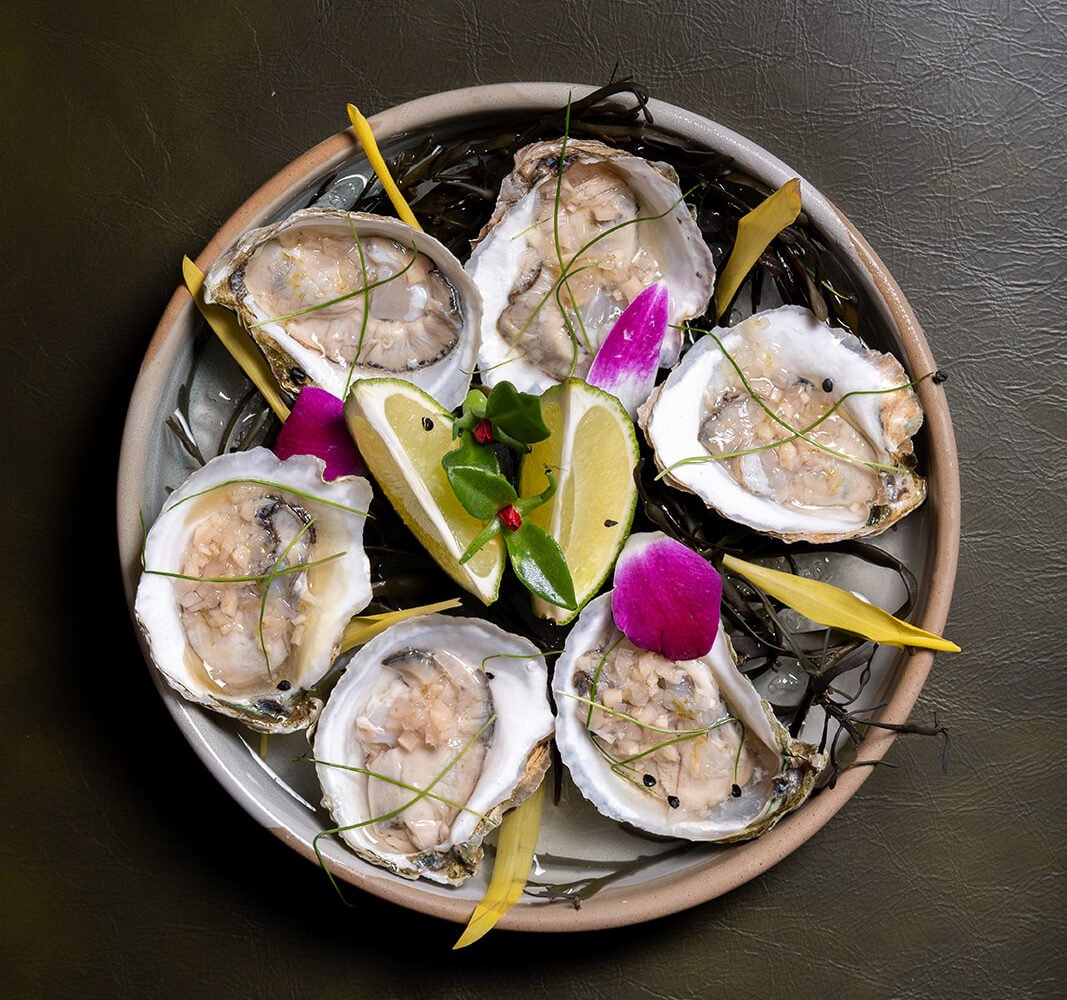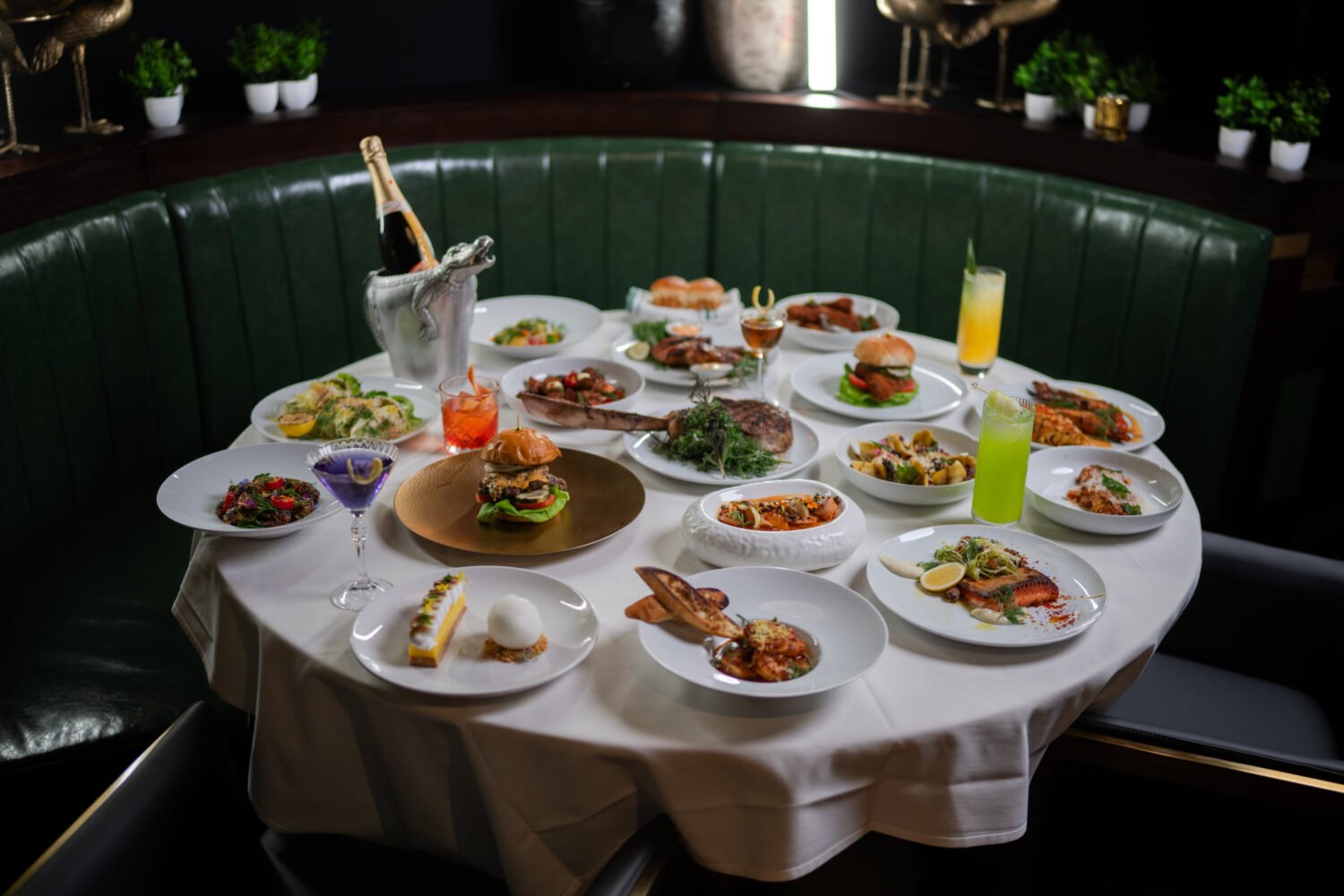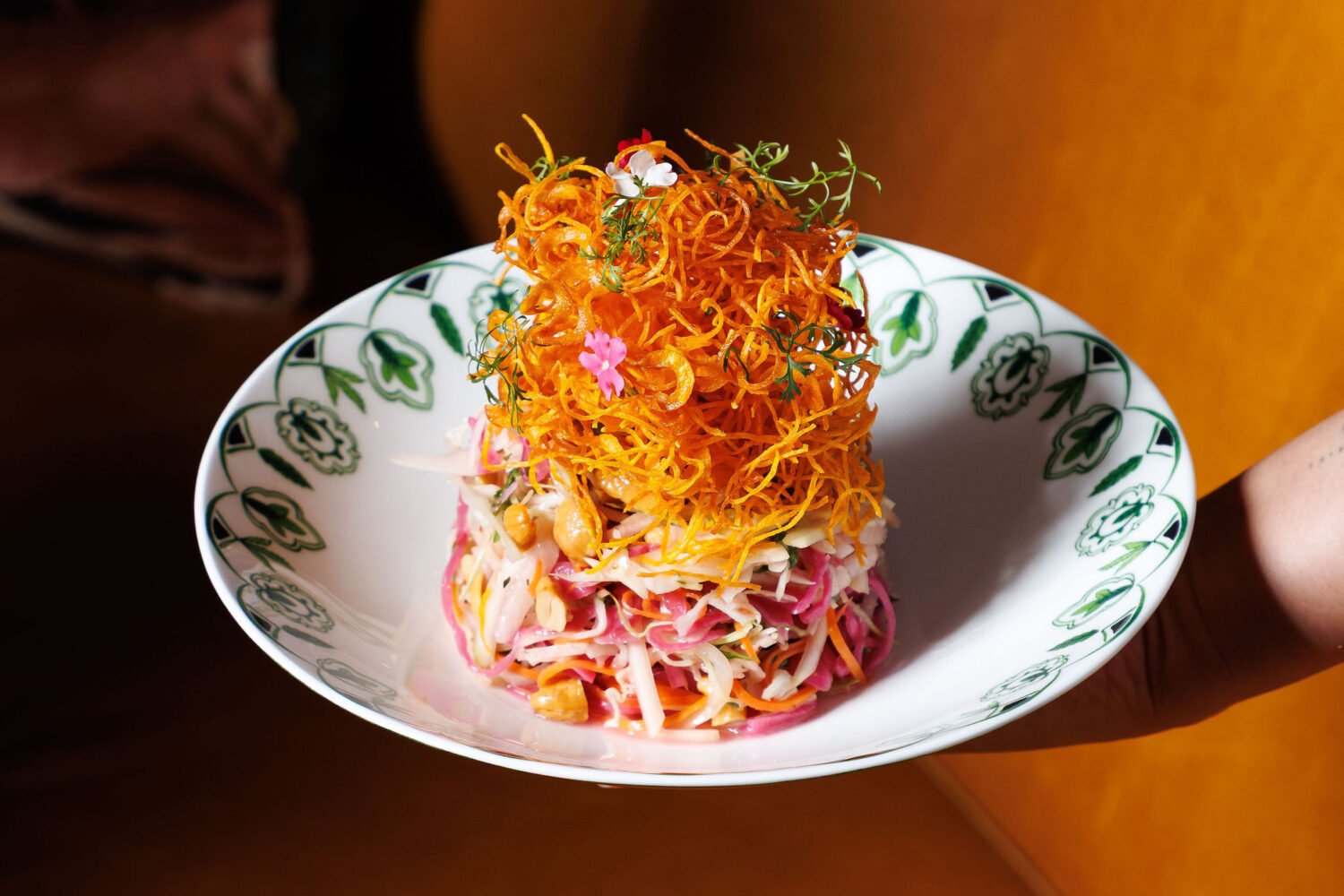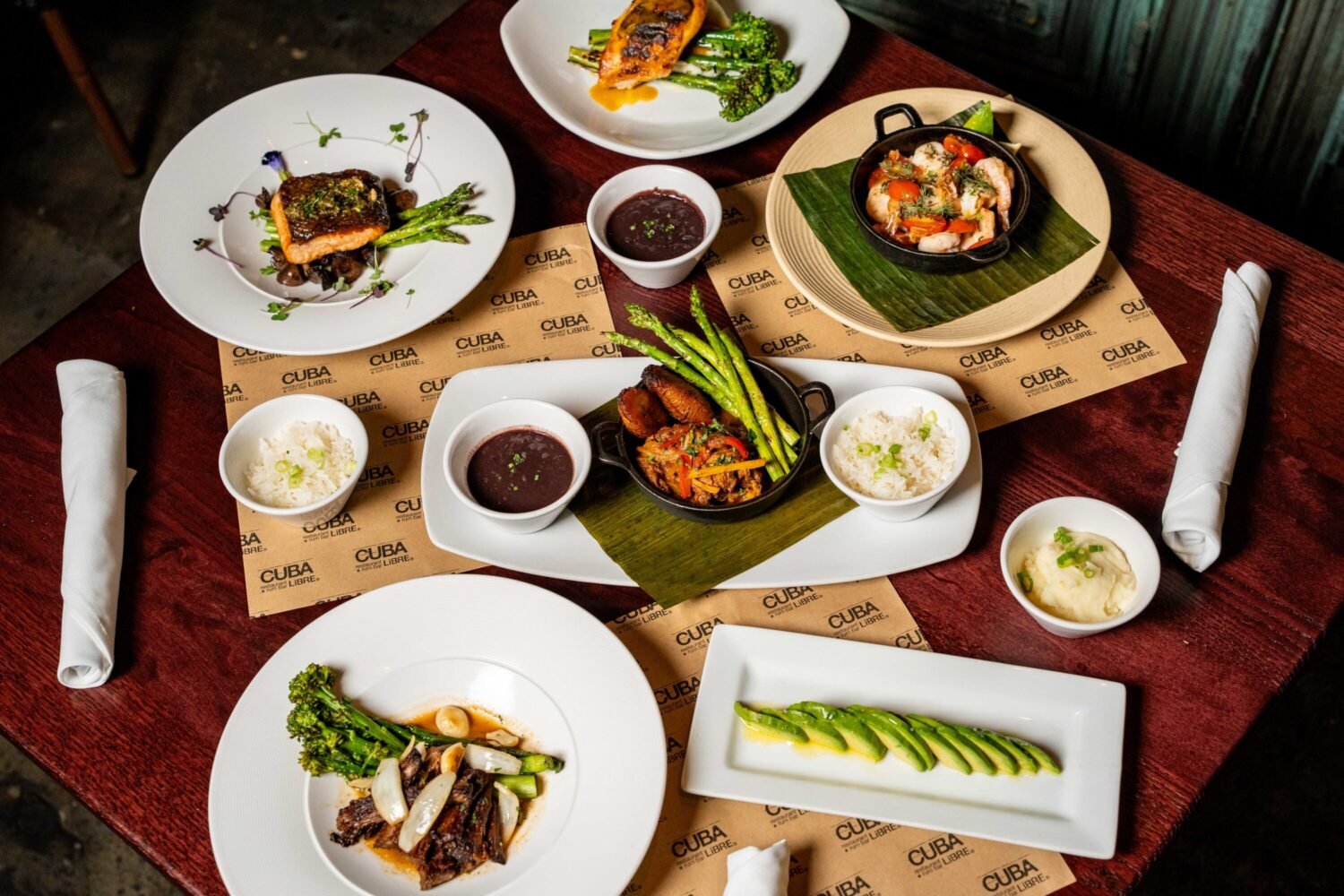Johnny Monis hasn’t hired a publicist and doesn’t plan to. He doesn’t make appearances, attend promotional events, or make the rounds of the dining room, as bottom-line-minded chefs are wont to do. At some point during a meal at Komi, his extraordinary DC restaurant east of Dupont Circle, you may catch a glimpse of him near the kitchen. Not long ago, he sported a backward baseball cap and a growth of beard; he looked like someone in hiding. Salting a piece of meat or fish with the concentration of a surgeon bearing down on a suture, dark locks spilling over his forehead, he calls to mind one of Johnny Depp’s darkly brooding loners.
When Komi opened five years ago, Monis’s looks were no small source of chatter, as much a reason for many young women (and young men) to pay a visit as the fried sardines with preserved lemon. Komi was then what would be called a promising restaurant, critics’ shorthand for an inconsistent place bursting with good ideas and sometimes good execution. It wasn’t so different from other energetic spots that open, do well, and then fade.
Except that there was something different about Monis’s arrival. A local, having grown up in Arlington, where his parents ran a pizzeria, he nevertheless exuded the air of a mysterious stranger—Roy Hobbs with a sauté pan.
That had to do partly with his itinerant’s résumé: He’d gone to the well-regarded Johnson & Wales cooking school in Charleston, South Carolina, but didn’t graduate; he worked in the kitchen for a while at the popular McCready’s, then found his way back home, taking the head job at Chef Geoff’s in downtown DC. By his own admission, he had never eaten at a fine-dining restaurant until college. “I’m very aware,” he says, “that I don’t have the résumé a lot of chefs have.”
There was nothing in his background to suggest what would happen next. Monis, without the help of outside investors, bought a townhouse on 17th Street that once had housed Roberto Donna’s Vivo! and started cooking. Most young cooks develop a reputation working for a bigger name before they even think about opening a place of their own.
Monis had no pedigree to speak of. His menu was unwieldy, as though he were intent on proving his worth in as many genres as he could, but it was the first restaurant in DC to offer crudo(marinated small plates of raw fish), and in its wit—a can of Pabst Blue Ribbon for $2, lollipops with the check—it aimed to align itself with such playfully serious titans of cuisine as Michel Richard.
Many dangers await young chefs: the danger of rising expectations, the danger of burnout. But Monis kept experimenting, pushing himself, refining his ideas, so that a meal at Komi one month wasn’t the same meal three months later. Komi not only made the leap from promising to good; it made the more difficult leap from good to very good.
This was where I thought Monis and Komi would level off. He must have been thinking the same thing because the next thing he did was to push himself once more.
“I wasn’t happy,” he says. “I knew we were capable of more—more with the level of food, more with the level of service. When most people renovate, it means getting bigger. Here, we got smaller.”
He shut down the restaurant for two weeks, remodeling the space with the help of his parents—removing the wood-burning grill, reducing the number of seats. When Komi reopened, it was a changed restaurant. Twenty-eight tables became 12. Gone was the à la carte menu; the only option was the prix-fixe menu, to which Monis appended a significant price tag: $84.
In roulette terms, this was akin to pushing the entire pile of chips onto a single number. A restaurant that only three years earlier had offered wood-oven pizzas was now demanding consideration as a culinary destination and inviting comparison to such big-time restaurants as Citronelle and CityZen.
If Komi isn’t the best restaurant in DC, it’s easily the most intimate, the most romantic, the most personal, the most soulful.
The house-made lollipops that come with the check are meant to remind you of a fun evening, but that’s not what lingers. What lingers is the earnestness of the experience, the conviction of a young and passionate operation that plays by its own rules.
Monis’s grandparents are from Greece, and the name Komi refers to the small beach near their home in Hios. The village remains untouched by modernity, and the summers Monis spent there were transformative: “I would go out with my grandfather, and we would pick what we were going to eat that day. It gave food the sense of time and place. If it wasn’t ready, we wouldn’t pick it and we wouldn’t eat it. Nothing fancy—just very simple, very good food.”
If Monis were so inclined, the tale could be mythologized and packaged. He refuses—partly out of shyness, partly out of principle. He didn’t embrace the flavors of his heritage because they would let him position the restaurant in a crowded market; he simply drifted toward his past as he pushed himself in the kitchen and, drifting, found his voice.
A selection of 12 small nibbles called mezzethakia sets the mood. There are no more appetizers; Monis has done away with them in favor of sending out small, exquisite tastes for the table to eat together. As important as the food, he seems to be saying, is the lingering, the conversation. Of the six entrées, four are intended for sharing and two of them are eaten with your hands.
Make a reservation and you’re reminded to allow at least 2½ hours for dinner.
The black-clad servers don’t push dishes or drinks, and they speak less with the authority of knowledge than with the excitement of discovery.
More than evoking the Mediterranean, Monis’s restaurant embodies it—its warmth and intimacy, its sensuality and languor, with fish so fresh its flesh fairly quivers and slow-cooked meats that evoke the lusty, communal experience of a roast on the beach.
One recent night, my meal began when a giant scallop shell was brought to the table, like a bottle of wine, for my inspection, and it ended with a tour-de-force presentation of spit-roasted baby goat, olive-oil-swabbed triangles of fresh pita, and a tray of embellishments. This was the degustation menu, a slightly more elaborate version of the standard four-course menu.
In between, I consumed more than 20 courses, some no more than a bite or two. The scallop, for example, had the sweet, rich fleshiness of the fish at the country’s best sushi bars. It was followed by a plate of thin-sliced amberjack, the translucent strips arrayed in a shallow pool of broth. The liquid was a consommé made from a cold smoked turbot, and its faintly oily richness accentuated the richness of the fish.
Perhaps no dish captures Monis’s sensual ideal quite like the two-biter that might be his signature: a Medjool date filled with mascarpone cheese, slow-roasted, drizzled with olive oil, and adorned with thick grains of sea salt laid with a jeweler’s precision. It’s the kind of thing cooks like to think they can reproduce at home—but they can’t do it with this intensity and clarity. The dish isn’t what it seems. It’s not about the date; it’s about the date as a means of delivery for the salt and olive oil. I don’t think I’ve ever seen a chef do more with two items that every high-end chef works with every day.
The degree of difficulty increases as the night goes on. The easy comparison is to José Andrés’s Minibar, with its profusion of tiny plates, but the motivation there is to push against the boundaries of cuisine. Komi isn’t as intellectual. It’s sensual, not clever.
Occasionally, Monis gives in to a voguish preciousness—sending out, say, a miniature pâte à choux with foie gras, a goat-cheese s’more, an eggshell filled with two preparations of egg (one runny, one soft) and topped with caviar. Even the crispy Caesar-salad dumpling, though tasty, is too reminiscent of the witty inversions of José Andrés and Michel Richard.
I suspect that as he continues to refine his approach, these facile attempts at playfulness may recede. Monis at his best is Monis rooted, putting the latest culinary ideas in the service of dishes that resonate with a sense of tradition and place. He turns pork belly, the current darling of high-end chefs, into souvlaki, a kebab-style two-biter topped with pickled cucumber that does what the street-food original never could. He rescues saganaki from Zorba the Greek cliché, pairing a melting square of the lightly salty cheese with a robust hanger-steak tartare surmounted by a raw quail egg; for crunch—and an additional hit of salt—he scatters a handful of fried capers. I don’t know which is more remarkable, the explosiveness of the flavors or the way the textures—soft, softer, softest—unfold in your mouth.
For most American chefs, texture means making something crispy on the outside and soft on the inside. Monis shares with the Japanese a fascination with the seemingly limitless possibilities between the extremities of crunchy and soft.
Compared with the reinventions of Richard and Andrés, Monis’s cuisine looks simple, at times almost Spartan. It depends for its power on its raw ingredients. Monis uses as many as six kinds of salt and four kinds of olive oil. But it’s the way he uses them, too—manipulating these ingredients the way a portrait painter deploys a variety of blacks and grays.
A rigorously hands-on chef, he never misses a night in the kitchen. He’s a tinkerer, laboring over combinations, rethinking them. “I commit my day,” he says of the 10 to 12 hours before dinner, “to either tweaking dishes or playing with new dishes.”
One of the plates that came as part of my degustation menu was a small sandwich. At most, it was four bites. But with all the detail lavished upon it, you would have thought it was an entrée fit for a $1,000 dinner: Monis had made the miniature sub roll that morning; he made the trio of cold cuts, including a soft, almost gelatinous mortadella that went inside it; and he made the creamy aïoli that he later spread on the meats. It ate like a sandwich; it resembled, in the delicacy of its construction, a napoleon.
He rolls his own pastas, using a different dough for each to achieve the textures he wants. Most nights there’s a preparation of agnolotti. A recent rendition garnished the tender folds of mint-filled pasta with fresh fava beans, English peas, and thick slices of charred octopus—clear, sharp flavors, all brought into focus by the arrangement of elements on the plate.
He makes his own guanciale, an Italian-style bacon that he uses stealthily, burying a small handful of tiny cubes inside a twirl of buttered tagliatelle and wild blueberries so the cubes act as a seasoning, detonating in the mouth like a smoky, fatty version of a grain of coarse salt.
What he doesn’t make himself Monis spends lavishly to procure. That’s one explanation for Komi’s high prices: As an independent, Monis lacks the financial backing of a Citronelle or a CityZen, both hotel restaurants.
His ability to maximize his raw materials was driven home one night with a sea urchin that was featured in another preparation of tagliatelle. In the dim light of the dining room, the orangey tint of the tossed noodles suggested a marinara sauce. I dug in expecting the sweetness and acidity of tomatoes, and I could almost imagine Monis in the back, chuckling at his patrons’ surprise: Not only had long lobes of sea urchin been arrayed atop the pasta, but the sauce was made from sea urchins, too. At a sushi bar, an order of sea urchin brings a small taste of the roe—a discrete piece of richness amid a lengthy sequence of dishes. This was sea urchin in high definition, with the sound turned all the way up: a briny custard that filled my mouth.
The final course, a communal one, crystallizes Monis’s vision of the restaurant. On my most recent visit, I went with my wife, and, having told her about the katsikaki, spit-roasted goat, I engaged in a bit of bait-and-switch and announced that I wanted to try something else. This didn’t sit well with her, and I saw her eyeing a platter of slow-roasted goat at the next table.
But then a roast suckling pig was set before us, and an evening of delicately wrought dishes gave way to something primal: Here, in a white-tablecloth restaurant, my wife and I were eating with our hands, tucking bits of the salty skin, crispy as bacon, into hot buttered pita along with ropes of the slow-cooked meat. Other diners were doing the same, upending the formality of fine dining as they made little sandwiches, scattering condiments across the table and laughing. It was wonderful.
The Greeks have a word for such occasions: enthousiasmos. It means more than excitement. Inspiration comes close. Being touched by the divine comes closer.
To talk of possession is to summon the name, once more, of Roy Hobbs, Bernard Malamud’s mythical baseballer who came out of nowhere. Hobbs burned bright, then vanished, but Monis—another natural—has ensured himself a second and a third act. He has shone and changed and grown.
The big idea that underlies the mission of most great restaurants—to lead the dining pilgrim to marvel at the limitless possibilities inherent in Cuisine—barely has traction here. Komi leads you outward, not inward, and encourages conversation, not reverence. You walk out at the end of the night sucking on a lemon-rosemary lollipop and rejoicing not just in the pleasures of a great meal but in having taken part in something authentic and true.
This review appeared in the September, 2008 issue of The Washingtonian.

